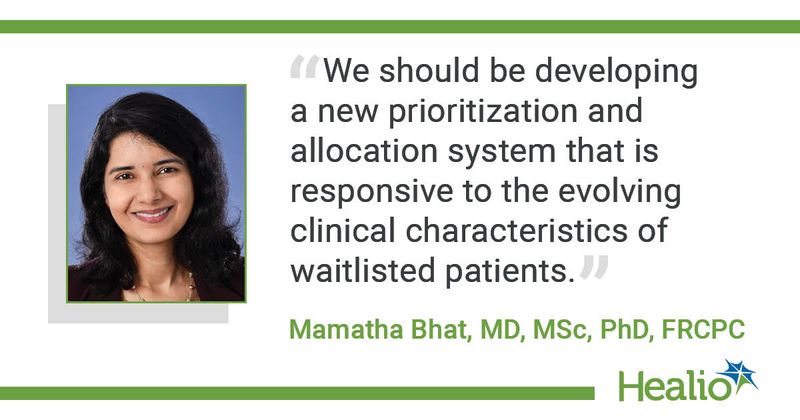Q&A: Women benefit from access to living donors in LT programs
Women who only accessed deceased donor liver transplant had worse outcomes than men independent of existing liver disease, broadened access to living donor LT may bridge this disparity gap women face.
“The MELD–based allocation system for LT was implemented to prioritize the sickest patients and improve equity in organ allocation. Although overall transplant waitlist mortality has decreased in the post-MELD era, LT access for women remains compromised,” Ravikiran S. Karnam, MD, Multi Organ Transplant Program, University Health Network, Toronto, Canada, and colleagues wrote. “Access to living donor LT (LDLT) shortens the median waiting time and decreases risk of dropout or death on the transplant waiting list.”

To investigate the benefit of access to LDLT among women compared with men, researchers performed a survival analysis and a competing-risk analysis on 1,289 patients (35.6% women; mean age, 56.1 years) listed for LT at the University Health Network in Toronto, Ontario, Canada. According to study results, missing potential living donor (pLD) assessments correlated with a higher median MELD-Na score among women who received deceased donor LT (DDLT) putting women at a disadvantage for LT access (HR = 1.29; 95% CI, 1.04-1.6). Further, women with a pLD assessment had a 1.92 times higher rate of receiving a transplant compared with women who did not have a pLD assessment (HR = 1.92; 95% CI, 1.51-2.44). Researchers noted women needed higher MELD-Na scores and to be much sicker, compared with men to qualify for LT access.
Mamatha Bhat, MD, MSc, PhD, FRCPC, Ajmera Transplant Program, University of Toronto, spoke with Healio Gastroenterology about how these findings translate to living donor allocation and the additional research needed to rectify health inequity.
Healio Gastroenterology: Why did your team undertake this investigation?
Mamatha Bhat: Interestingly, I was asked to review this topic for the Canadian Liver meeting in 2019, this is when I became aware of the statistics and the disadvantage women face on the waiting list due to various factors.
The MELD-Na score was transformational in decreasing overall waitlist mortality. However, it was developed at a time when hepatitis C virus was the dominant indication for transplant. Nonalcoholic steatohepatitis and ALD have become the leading indications for LT at this time and hepatocellular carcinoma has also increased as an indication for exception points on the waitlist. Over time, we have realized that there are certain subgroups that are disadvantaged by this score.
For women, the disadvantage is multifactorial. Firstly, the MELD-Na in women appears to underrepresent the degree of illness; specifically, the creatinine in women tends to be lower due to lower muscle mass and the sodium is also under reflected. Women with cholestatic liver disease are also disadvantaged, due to the bilirubin being underweighted in the MELD-Na score. Beyond prioritization, organ allocation depends on the match between the donor and recipient liver. Previous studies have reported one of the factors as most deceased donor organs being from male donors, which could be disadvantageous to women with a smaller body habitus. Therefore, anthropometric measures are also a critical contributor.
A study by Locket et al in JAMA Surgery, 2020, confirmed that women were 14.4% less likely to receive a deceased organ compared with men having accounted for geographic location, MELD score and candidate anthropometric as well as liver measurements.
Healio: What is the most important take-home message?
Bhat: LDLT is helpful to all patients on the waiting list, regardless of their clinical characteristics. What we show in our study is that as a program performing LDLTs, we can alleviate sex disparity on the waiting list. In fact, using competing risk analysis, we found that women benefited from access to LDLT 1.38 times more than men.
Healio: How do these results inform liver transplant allocation among women going forward and what additional research is needed?
Bhat: Various studies have looked into how sex disparity on the waiting list could be rectified. However, none of the adjustments for factors such as GFR and liver volume have been able to rectify this disparity. Therefore, this is a very complex problem with no simple solution, given the number of variables involved and dynamics on the waiting list.
We should be developing a new prioritization and allocation system that is responsive to the evolving clinical characteristics of waitlisted patients. It is likely that the optimal prioritization would vary based on the unique considerations of each jurisdiction in terms of indication for transplant and supply to demand mismatch.
Until such time, as we develop a more optimal and equitable prioritization and allocation system, LDLT could be considered particularly if there is a substantial mismatch between organ supply and demand in a particular jurisdiction.
Healio: Is there anything else you'd like to mention to our readers?
Bhat: There are differences in deceased donor organ availability across jurisdictions and it may be that sex disparities are less obvious in jurisdictions where there is less of a mismatch between supply and demand of organs. Previous studies have highlighted geographic location as an important factor; referral of patients to centers with LDLT expertise and significant volumes could be discussed with patients as being of benefit to them if there is a significant mismatch in supply and demand.
Expansion of access to LDLT would be helpful especially for subgroups underserved by the MELD-Na score.
